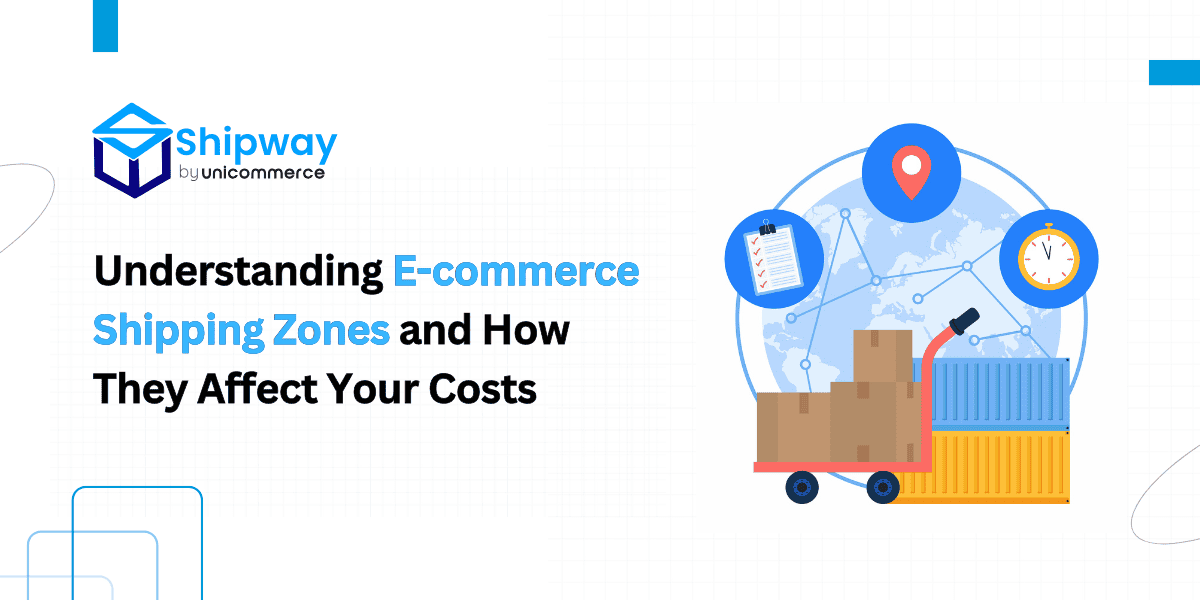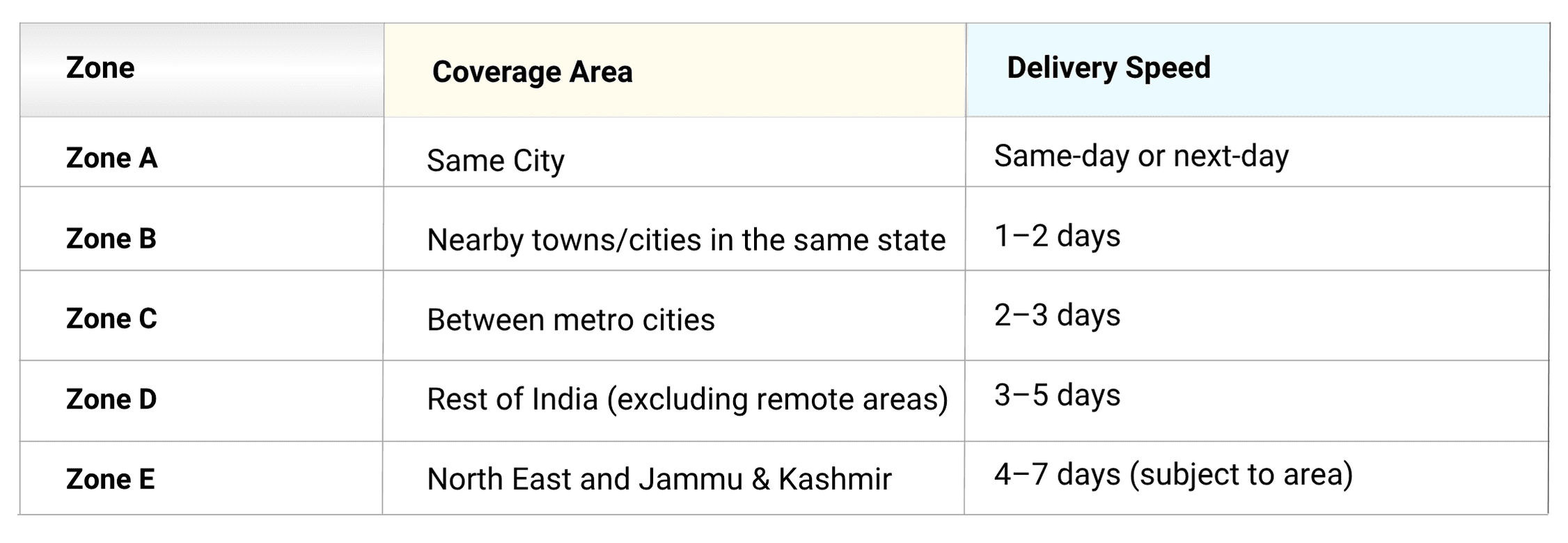Shipping zones might sound technical, but they’re actually pretty straightforward. Couriers charge more depending on how far the package needs to travel from where it was picked up. So, sending something within the same city will usually cost less than shipping it across the country. The farther your package has to travel from its origin, the higher the shipping cost. It’s how most courier companies work behind the scenes.
If you’re an e-commerce seller in India, knowing how these zones are set up can make a real difference. It helps you set the right product prices, avoid surprise costs, and plan your deliveries more efficiently. For instance, you ship two identical products, one going from Delhi to Noida, and the other from Delhi to Guwahati. Same item, same packaging, but the second one costs you almost double to deliver. Why? Because it’s crossing multiple shipping zones.
In this blog, we’ll break down what shipping zones really are, how they impact your costs, and how you can use that knowledge to run a more profitable, predictable business.
What are Shipping Zones in India?
If you’ve ever wondered why sending a package to one city costs more than another, even for the same product, you’re not alone. The reason often comes down to shipping zones.
Shipping zones are how courier companies group delivery locations based on distance from your pickup point. The farther the delivery address, the higher the zone, and usually, the higher the shipping cost. This system helps couriers estimate delivery time, fuel use, and effort required to complete the order.
In India, most logistics providers follow a simple zone structure that looks something like this:
- Zone A – Local deliveries within the same city
- Zone B – Nearby towns or cities in the same state
- Zone C – Between metro cities (like Delhi to Mumbai)
- Zone D – Across the rest of India, excluding a few remote regions
- Zone E – Includes deliveries to or from the North East and Jammu & Kashmir
These zones aren’t just for pricing; they also impact how quickly your orders reach your customers. A Zone A delivery might arrive the same day, while a Zone E delivery could take a few extra days and cost more.
For you as a seller, knowing how shipping zones work means you can plan better, set the right delivery expectations, avoid margin losses on long-distance orders, and even choose warehouses or courier partners more strategically. Let’s learn more about shipping zones.
How Shipping Zones Impact Delivery Speed in E-commerce Logistics
Shipping zones aren’t just about cost; they play a big role in how fast your orders reach your customers. Since zones are based on the distance between your warehouse and the customer’s delivery address, the farther the zone, the longer the delivery time.
Let’s break it down with a simple scenario.
Imagine your inventory is stored in a warehouse in Mumbai (West Zone), and you receive two orders, one from Pune and the other from Kolkata. The Pune order falls within the same zone as your warehouse, so the delivery is likely to be quicker and cheaper.
Now take the Kolkata order. Since it’s in a different zone (East Zone), the package has to travel a much longer distance, possibly pass through multiple courier hubs, and take more time to reach the customer. Naturally, the shipping fee is higher, and the risk of delays also increases.
Another thing that affects cost and delivery time is the shipping mode. Couriers often use air shipping for faster, long-distance deliveries, which is quicker but more expensive. Surface shipping is slower but cheaper, and better for nearby or non-urgent orders. It all comes down to how fast your customer wants the order and what you’re willing to spend to get it there.
How does Zones Impact Shipping Cost Calculation?
Shipping zones directly influence how much you pay to ship based on distance, weight, and courier policies. In fact, 24% of consumers cancel their orders due to slow delivery, which shows how important it is to plan your shipping strategy wisely.
Along with distance and weight, the shipping mode also plays a big role in cost. Air shipping is often used for long-distance or express deliveries across higher zones; it’s faster but comes at a higher price. Surface shipping, on the other hand, is more economical but takes longer, especially across zones. Choosing the right mode based on order urgency and zone can help you balance speed and cost more effectively.
1. Weight and size considerations
When it comes to shipping charges, it’s not just about how far your order has to travel; size and weight matter too. Most courier partners calculate shipping fees based on either the actual weight or the volumetric weight of a package (whichever is higher). This means that even if your product is lightweight but takes up a lot of space, you could be charged more. Flipkart uses this method to determine costs, which is why understanding product packaging is important. Amazon also takes multiple factors into account, like pickup and delivery pin codes, payment mode, and total weight through its shipping rate calculator. As a seller, knowing how volume impacts your shipping costs can help you optimize packaging and avoid unexpected charges.
When selling across multiple platforms and working with various courier partners, accurate shipping cost calculation is crucial, as weight-related errors alone can lead to a 5% to 9% drop in your margins.
2. Carrier-specific Zone Mapping
Shipping zones aren’t the same for every courier; each one maps zones based on its own delivery network and hub locations. This directly affects both serviceability and shipping costs. While one courier might treat a location as a nearby zone, another might classify it as distant, leading to higher rates or even limited service. On top of that, shipping charges also vary with weight and package size, even within the same zone. So, understanding how each courier defines its zones helps you pick the right partner, ensure coverage, and estimate costs more accurately.
3. Distance
Shipping zones are mainly based on distance. Couriers split regions into zones depending on how far the package needs to go from the pickup point. Simply put, the farther it has to travel, the higher the zone, and the more it’ll cost to ship.
Being a multi-channel seller, you can’t rely on one courier partner; it may or may not deliver to a particular location, or may charge high prices, or there could be weight discrepancies. That’s where partnering with a courier aggregator can help, as it can help you choose the best courier partner according to the package type, weight, and delivery location. Let’s see how.
Why Partnering With a Shipping Aggregator Matters for E-commerce Sellers
A shipping aggregator brings everything, from couriers to tracking, returns, and cost control, into one easy-to-manage platform.
1. Optimize Operations
Some zones have higher RTOs, and sometimes shipments to these zones can be more expensive. In such cases, aggregators provide detailed analytics to answer these questions, which can help you refine your logistics strategy.
2. Tools Availability
Shipping aggregators offer tools like shipping cost calculators that help e-commerce brands estimate delivery charges accurately before shipping an order.
3. Misc Issues
Issues like lost packages, delays, or RTOs are common, but courier aggregators help manage them smoothly without the hassle of coordinating with multiple partners.
How Shipway Helps You Simplify and Scale Your Shipping Operations
Shipway is an all-in-one eCommerce logistics solution that helps you manage deliveries across 29,000+ pin codes quickly and cost-effectively through its powerful courier aggregation platform.
-
Multiple Courier Options
Choose the most suitable partner for each shipment from top carriers like Bluedart, Delhivery, Xpressbees, DTDC, and others, all in one place.
-
Automated NDR Handling
Track and manage non-delivery reports effortlessly with Shipway’s automated NDR solution, reducing manual follow-ups and RTOs.
-
Fraud COD Order Detection
As you know, over 50% of COD orders fall into the RTO category, but Shipway offers the perfect solution to tackle this. With our tools, you can increase your delivery success rate by up to 95%.
-
Flexible Carrier Selection
Pick from 11+ pre-integrated courier services or plug in your own delivery partner, whichever fits your business best.
-
Greater Control Beyond Marketplaces
Avoid relying solely on Amazon for pickups, deliveries, or remittance. Shipway puts the control back in your hands.
-
Smart Courier Allocation
Automatically assign orders to the most cost-effective and serviceable courier based on pin code, performance, and pricing.
-
Seamless Shopify Integration
Easily connect your Shopify store to Shipway and manage all your shipping needs in one place with access to multiple couriers and smart courier allocation. Ship your Shopify Orders with the best shipping solution for your Shopify orders.
-
RTO Reduction Suite
Cut return-to-origin (RTO) rates by up to 30% and prevent fraud using Shipway’s unified NDR management system.
-
Returns Made Easy
Automate returns and exchanges directly from your Shopify store. Set up a branded return page, define your own return policies, manage pickups, and even offer instant refunds.
-
Real-Time Tracking & Notifications
Keep customers informed and reduce WISMO queries by up to 80% with branded tracking pages and timely delivery updates via WhatsApp, SMS, and email.
Final Say
Shipping zones might seem like a small detail, but they can have a big impact on your costs and delivery timelines. For e-commerce sellers, knowing how they work helps you plan smarter and avoid unnecessary losses. And if managing all of this feels like too much, that’s where a solution like Shipway comes in. It takes the load off by helping you handle everything from courier selection to returns, so you can focus more on selling and less on shipping.




